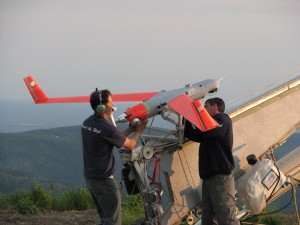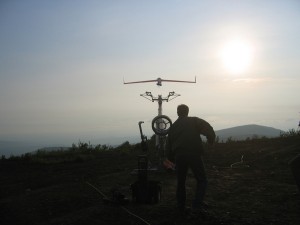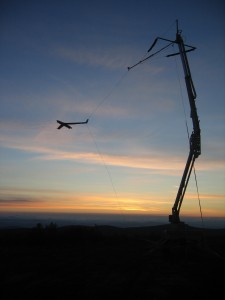UAF secures up to $47 million for unmanned aircraft studies
September 23, 2010

Amy Hartley
907-474-5823
9/23/10
The United States Navy has awarded the University of Alaska Fairbanks up to $47 million to test and evaluate payloads aboard small, unmanned aircraft.
The UA Unmanned Aircraft Program, part of the UAF Geophysical Institute, will lead the research. The program will test unmanned aircraft and how they perform in harsh conditions. In addition, they will evaluate payloads, which are packages of data-collection instruments carried on the aircraft.
The program currently has a fleet of four unmanned aerial systems. Each weighs about 40 pounds and has a wingspan of 10 feet. The aircraft are Insitu ScanEagles — relatively compact models — that can fly more than 20 hours at a time, boosting their versatility for working in remote and often extreme conditions. The fleet will soon expand in size and diversity, adding new models of aircraft that are both larger and smaller than the ScanEagles.

This experience was key to landing the Navy contract, said Greg Walker, manager of the UA Unmanned Aircraft Program. “The Navy was looking for proven performance and we believe our experiences in harsh environments secured this award.”
To boost the program’s ability to meet a broad spectrum of challenges, the program has partnered with 27 industry leaders, including large corporations, small businesses, not-for-profit corporations and other universities. The diversity achieved by so many partners allows the team to address a multitude of research scenarios the Navy could assign as part of the contract.

The University of Alaska Unmanned Aircraft Program was created in 2006. The program’s fleet is based at Poker Flat Research Range, located north of Fairbanks on the Steese Highway.
ADDITIONAL CONTACTS: Greg Walker, UA Unmanned Aircraft Program manager, 907-455-2102, or gregory.walker@gi.alaska.edu. Marmian Grimes, UAF public information officer, at 907-474-7902 or marmian.grimes@alaska.edu.
AH/9-23-10/053-11


